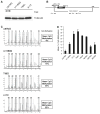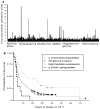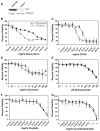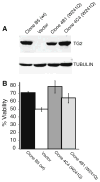The transglutaminase 2 gene is aberrantly hypermethylated in glioma
- PMID: 20596752
- PMCID: PMC3019272
- DOI: 10.1007/s11060-010-0277-7
The transglutaminase 2 gene is aberrantly hypermethylated in glioma
Abstract
Transglutaminase 2 (TG2) is a ubiquitously expressed protein that catalyzes protein/protein crosslinking. Because extracellular TG2 crosslinks components of the extracellular matrix, TG2 is thought to function as a suppressor of cellular invasion. We have recently uncovered that the TG2 gene (TGM2) is a target for epigenetic silencing in breast cancer, highlighting a molecular mechanism that drives reduced TG2 expression, and this aberrant molecular event may contribute to invasiveness in this tumor type. Because tumor invasiveness is a primary determinant of brain tumor aggressiveness, we sought to determine if TGM2 is targeted for epigenetic silencing in glioma. Analysis of TGM2 gene methylation in a panel of cultured human glioma cells indicated that the 5' flanking region of the TGM2 gene is hypermethylated and that this feature is associated with reduced TG2 expression as judged by immunoblotting. Further, culturing glioma cells in the presence of the global DNA demethylating agent 5-aza-2'-deoxycytidine and the histone deacetylase inhibitor Trichostatin A resulted in re-expression of TG2 in these lines. In primary brain tumors we observed that the TGM2 promoter is commonly hypermethylated and that this feature is a cancer-associated phenomenon. Using publically available databases, TG2 expression in gliomas was found to vary widely, with many tumors showing overexpression or underexpression of this gene. Since overexpression of TG2 leads to resistance to doxorubicin through the ectopic activation of NFκB, we sought to examine the effects of recombinant TG2 expression in glioma cells treated with commonly used brain tumor therapeutics. We observed that in addition to doxorubicin, TG2 expression drove resistance to CCNU; however, TG2 expression did not alter sensitivity to other drugs tested. Finally, a catalytically null mutant of TG2 was also able to support doxorubicin resistance in glioma cells indicating that transglutaminase activity is not necessary for the resistance phenotype.
Figures






Similar articles
-
The transglutaminase 2 gene (TGM2), a potential molecular marker for chemotherapeutic drug sensitivity, is epigenetically silenced in breast cancer.Carcinogenesis. 2008 Mar;29(3):510-8. doi: 10.1093/carcin/bgm280. Epub 2008 Jan 3. Carcinogenesis. 2008. PMID: 18174247
-
Ataxia-Telangiectasia, Mutated (ATM)/Nuclear Factor κ light chain enhancer of activated B cells (NFκB) signaling controls basal and DNA damage-induced transglutaminase 2 expression.J Biol Chem. 2012 May 25;287(22):18330-41. doi: 10.1074/jbc.M112.339317. Epub 2012 Apr 4. J Biol Chem. 2012. PMID: 22493284 Free PMC article.
-
TGM2 inhibition attenuates ID1 expression in CD44-high glioma-initiating cells.Neuro Oncol. 2013 Oct;15(10):1353-65. doi: 10.1093/neuonc/not079. Epub 2013 Jul 21. Neuro Oncol. 2013. PMID: 23877317 Free PMC article.
-
Biological Implications and Functional Significance of Transglutaminase Type 2 in Nervous System Tumors.Cells. 2024 Apr 11;13(8):667. doi: 10.3390/cells13080667. Cells. 2024. PMID: 38667282 Free PMC article. Review.
-
Transglutaminase 2 and NF-κB: an odd couple that shapes breast cancer phenotype.Breast Cancer Res Treat. 2013 Jan;137(2):329-36. doi: 10.1007/s10549-012-2351-7. Epub 2012 Dec 8. Breast Cancer Res Treat. 2013. PMID: 23224146 Review.
Cited by
-
A Bayesian ensemble approach with a disease gene network predicts damaging effects of missense variants of human cancers.Hum Genet. 2013 Jan;132(1):15-27. doi: 10.1007/s00439-012-1218-7. Epub 2012 Aug 21. Hum Genet. 2013. PMID: 22907477
-
Transglutaminase is a tumor cell and cancer stem cell survival factor.Mol Carcinog. 2015 Oct;54(10):947-58. doi: 10.1002/mc.22375. Epub 2015 Aug 10. Mol Carcinog. 2015. PMID: 26258961 Free PMC article. Review.
-
Transglutaminase regulation of cell function.Physiol Rev. 2014 Apr;94(2):383-417. doi: 10.1152/physrev.00019.2013. Physiol Rev. 2014. PMID: 24692352 Free PMC article. Review.
-
Role of epigenetics in corneal health and disease.Prog Retin Eye Res. 2025 Jan;104:101318. doi: 10.1016/j.preteyeres.2024.101318. Epub 2024 Nov 14. Prog Retin Eye Res. 2025. PMID: 39547455 Review.
-
Exploring the Role of Transglutaminase in Patients with Glioblastoma: Current Perspectives.Onco Targets Ther. 2022 Mar 19;15:277-290. doi: 10.2147/OTT.S329262. eCollection 2022. Onco Targets Ther. 2022. PMID: 35340676 Free PMC article. Review.
References
-
- Weinberg RA. How cancer arises. Sci Am. 1996;275:62–70. - PubMed
-
- Bird A. The essentials of DNA methylation. Cell. 1992;70:5–8. - PubMed
-
- Wolffe AP. Chromatin remodeling: why it is important in cancer. Oncogene. 2001;20:2988–2990. - PubMed
-
- Lorand L, Conrad SM. Transglutaminases. Mol Cell Biochem. 1984;58:9–35. - PubMed
-
- Aeschlimann D, Thomazy V. Protein crosslinking in assembly and remodelling of extracellular matrices: the role of transglutaminases. Connect Tissue Res. 2000;41:1–27. - PubMed
Publication types
MeSH terms
Substances
Grants and funding
LinkOut - more resources
Full Text Sources
Other Literature Sources
Medical
Miscellaneous

